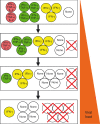T-cell exhaustion: characteristics, causes and conversion
- PMID: 20201977
- PMCID: PMC2842494
- DOI: 10.1111/j.1365-2567.2010.03255.x
T-cell exhaustion: characteristics, causes and conversion
Abstract
T-cell exhaustion is characterized by the stepwise and progressive loss of T-cell functions and can culminate in the physical deletion of the responding cells. Exhaustion is well-defined during chronic lymphocytic choriomeningitis virus infection and commonly develops under conditions of antigen-persistence, which occur following many chronic infections that are of significant public health concern including hepatitis B virus, hepatitis C virus and human immunodeficiency virus infections, as well as during tumour outgrowth. Exhaustion is not a uniformly disabled setting as a gradation of phenotypic and functional defects can manifest, and these cells are distinct from prototypic effector, memory and also anergic T cells. We are gaining insights into the extrinsic and intrinsic factors that determine the severity of exhaustion. These include the duration and magnitude of antigenic activation, availability of CD4 T-cell help, the levels of stimulatory and suppressive cytokines, as well as the expression of activatory and inhibitory receptors. More information is now becoming available regarding the molecular mechanisms that attenuate the responsiveness of exhausted T cells. As the parameters that dictate exhaustion are more thoroughly defined, this is fostering the development of methods that prevent and rejuvenate functionally inferior responses. In this article we discuss our current understanding of the properties of exhausted T cells and the mechanisms that promote and maintain this state.
Figures



References
-
- Moskophidis D, Lechner F, Pircher H, Zinkernagel RM. Virus persistence in acutely infected immunocompetent mice by exhaustion of antiviral cytotoxic effector T cells. Nature. 1993;362:758–61. - PubMed
Publication types
MeSH terms
Substances
Grants and funding
LinkOut - more resources
Full Text Sources
Other Literature Sources
Research Materials

